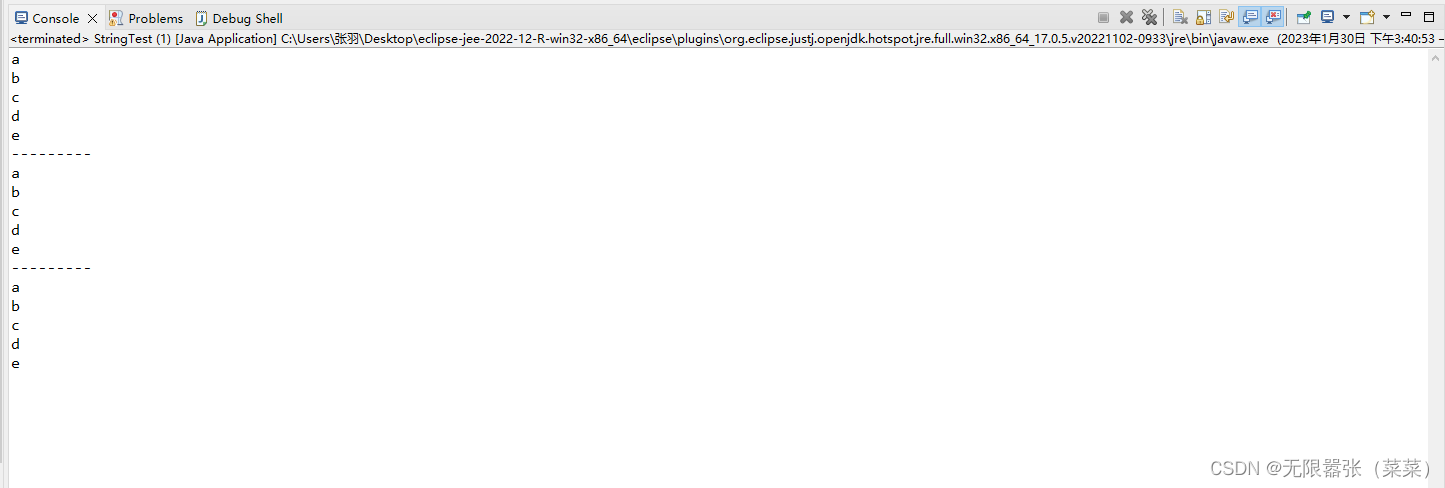目录
String类的概述及构造方法(String类是Java中最常见的类)
String的特点
String类的判断功能
模拟登录案例
String类的获取功能
两个小练习
String类的转换功能和String类的其他功能
string类练习
String类的概述及构造方法(String类是Java中最常见的类)
String类概述–字符串是由多个字符组成的一串数据
–字符串可以看成是字符数组
构造方法–public String(String original)
–public String(char[] value)
–public String(char[] value,int offset,int count)
–直接赋值也可以是一个对象
4种字符方式赋值如下:
package com.demo02;/* * String:字符串类 * 由多个字符组成的一串数据 * 字符串本身就是一个字符数组 * *构造方法: * String(String original):把字符串数据封装成字符串对象 * String(char[] value):把字符数组的数据封装成字符串对象 * String(char[] value, int index, int count):把字符数组中的一部分数据封装成字符串对象 * * 注意:字符串是一种比较特殊的引用数据类型,直接输出字符串对象输出的是该对象中的数据 */public class StringDemo {public static void main(String[] args) {//方式1//String(String original):把字符串数据封装成字符串对象String s1 = new String("hello");System.out.println("s1:"+s1);System.out.println("---------");//方式2//String(char[] value):把字符数组的数据封装成字符串对象char[] chs = {'h','e','l','l','o'};String s2 = new String(chs);System.out.println("s2:"+s2);System.out.println("---------");//方式3//String(char[] value, int index, int count):把字符数组中的一部分数据封装成字符串对象//String s3 = new String(chs,0,chs.length);//char[] chs = {'h','e','l','l','o'};String s3 = new String(chs,0,5);//从哪个位置开始,多长System.out.println("s3:"+s3);System.out.println("---------");//方式4,比较常用的String s4 = "hello";System.out.println("s4:"+s4);}}
String的特点
通过构造方法创建字符串对象–String s = new String(“hello”);
直接赋值创建字符串对象–String s = “hello”;区别是什么?
通过构造方法创建的字符串是在堆内存,直接复制方式创建对象的方法是在常量池。
基本数据类型:比较的是基本数据类型的值是否相同。
引用数据类型:比较的是引用数据类型的地址是否相同。
package com.demo02;public class StringDemo2 {public static void main(String[] args) {String s1 = new String("hello");String s2 = "hello";System.out.println("s1:"+s1);System.out.println("s2:"+s2);System.out.println("s1==s2:"+(s1==s2)); //falseString s3 = "hello";System.out.println("s1==s3:"+(s1==s3)); //false 放回的地址是不是相等System.out.println("s2==s3:"+(s2==s3)); //trueSystem.out.println(s1.equals(s2));// 返回的值是不是相等}}
String类的判断功能
boolean equals(Object obj)——比较两个字符串的值是否相等boolean equalsIgnoreCase(String str)——不管大小写,都会转化成一样的去做比较boolean startsWith(String str)——从哪个字符串开始boolean endsWith(String str)——从哪个字符串结束其中API有关equals

package com.demo03;public class StringDemo {public static void main(String[] args) {//创建字符串对象String s1 = "hello";String s2 = "hello";String s3 = "Hello";//boolean equals(Object obj):比较字符串的内容是否相同System.out.println(s1.equals(s2));System.out.println(s1.equals(s3));System.out.println("-----------");//boolean equalsIgnoreCase(String str):比较字符串的内容是否相同,忽略大小写System.out.println(s1.equalsIgnoreCase(s2));System.out.println(s1.equalsIgnoreCase(s3));System.out.println("-----------");//boolean startsWith(String str):判断字符串对象是否以指定的str开头System.out.println(s1.startsWith("he"));System.out.println(s1.startsWith("ll"));System.out.println("-----------");//boolean endsWith(String str):判断字符串对象是否以指定的str结尾System.out.println(s1.endsWith("ll"));}}
模拟登录案例
package com.demo03;import java.util.Scanner;/* * 给三次机会,并提示还有几次 * * 分析: * A:定义两个字符串对象,用于存储已经存在的用户名和密码 * B:键盘录入用户名和密码 * C:键盘录入用户名和密码和已经存在的用户名和密码做比较 * 如果内容相同,表示登录成功 * 如果内容不同,登录失败,并提示还有几次机会 */public class StringTest {public static void main(String[] args) {//定义两个字符串对象,用于存储已经存在的用户名和密码String username = "admin";String password = "admin";//给三次机会,用for循环for(int x=0; x<3; x++) {//键盘录入用户名和密码Scanner sc = new Scanner(System.in);System.out.println("请输入用户名:");String name = sc.nextLine();System.out.println("请输入密码");String pwd = sc.nextLine();if(username.equals(name) && password.equals(pwd)) {System.out.println("登录成功");break;}else {if((2-x) ==0) {System.out.println("用户名和密码被锁定,请与管理员联系");}else {System.out.println("登录失败,你还有"+(2-x)+"次机会"); //2,1,0}}}}}
 String类的获取功能
String类的获取功能
int length() —— 字符串长度,其实也就是字符个数char charAt(int index) —— 获取指定索引处的字符int indexOf(String str) —— 获取str的字符串对象中第一次出现的索引String substring(int start)——从start开始截取字符串String substring(int start,int end)——从start开始,到end结束截取字符串,包括start,不包括endpackage com.demo04;public class StringDemo {public static void main(String[] args) {//创建字符串对象String s = "helloworld";//int length():获取字符串的长度,也就是字符个数System.out.println(s.length());System.out.println("--------");//char charAt(int index):获取指定索引的字符System.out.println(s.charAt(0));System.out.println(s.charAt(1));System.out.println("--------");//int indexOf(String str):获取str的字符串对象中第一次出现的索引System.out.println(s.indexOf("l"));System.out.println(s.indexOf("owo"));System.out.println(s.indexOf("ak"));System.out.println("--------");//String substring(int start):从start开始截取字符串System.out.println(s.substring(0));System.out.println(s.substring(5));System.out.println("--------");//String substring(int start,int end):从start开始,到end结束截取字符串,包括start,不包括endSystem.out.println(s.substring(0, s.length()));System.out.println(s.substring(3,8));}}
两个小练习:
练习1:遍历字符串
练习2:统计一个字符中大写字符。小写字符,数字字符出现的次数,不考虑其他字符
练习1:遍历字符串
package com.demo04;/* * 遍历字符串(获取字符串中的每一个字符串) */public class StringTest {public static void main(String[] args) {//创建一个字符串对象String s = "abcde";//原始做法System.out.println(s.charAt(0));System.out.println(s.charAt(1));System.out.println(s.charAt(2));System.out.println(s.charAt(3));System.out.println(s.charAt(4));System.out.println("---------");//for循环好近for(int x=0; x<5; x++) {System.out.println(s.charAt(x));}System.out.println("---------");//利用s.length()获取字符串长度for(int x=0; x<s.length(); x++) {System.out.println(s.charAt(x));}}}练习2:统计一个字符中大写字符。小写字符,数字字符出现的次数,不考虑其他字符
package com.demo04;import java.util.Scanner;/* * 练习2:统计一个字符中大写字符。小写字符,数字字符出现的次数,不考虑其他字符 * * 分析 * A:键盘录入一个字符串数据 * B:定义三个统计变量,初始值都是0 * C:遍历每一个字符串,得到每一个字符 * D:拿字符进行判断 * 加入ch是一个字符 * 大写:ch>='A' && ch<='Z' * 小写:ch>='a' && ch<='z' * 数字ch>='0' && ch<='9' * E:输出结果 */public class StringTest2 {public static void main(String[] args) {//创建一个对象Scanner sc = new Scanner(System.in);System.out.println("请输入字符");// 接收数据String s = sc.nextLine();//定义统计字符int bigCount = 0;int smallCount = 0;int numberCount = 0;//遍历字符,得到每一个字符for(int x=0; x<s.length(); x++) {char ch = s.charAt(x);//字符判断if(ch>='A' && ch<='Z') {bigCount++;}else if(ch>='a' && ch<='z') {smallCount++;}else if(ch>='0' && ch<='9') {numberCount++;}else {System.out.println("该字符"+ch+"非法");}}//输出结果System.out.println("大写字符"+bigCount+"个");System.out.println("小写字符"+smallCount+"个");System.out.println("数字字符"+numberCount+"个");}}String类的转换功能和String类的其他功能
char[] toCharArray()——把字符串转换为字符数组String toLowerCase()——把字符串转换为小写字符串String toUpperCase()——把字符串转换为大写字符串package com.demo05;/* * * 字符串遍历 */public class StringDemo {public static void main(String[] args) {//创建字符串String s = "abcde";//char[] toCharArray():把字符串转化成字符数组char[] chs = s.toCharArray();for(int x=0; x<chs.length; x++) {System.out.println(chs[x]);}System.out.println("-----------");//String toLowerCase():把字符串转换成小写字符串System.out.println("HelloWorld".toLowerCase());//String toUpperCase():把字符串转换成大写字符串System.out.println("HelloWorld".toUpperCase());}} 其他功能:
其他功能:
去除字符串两端空格
–String trim()
按照指定符号分割字符串
–String[] split(String str)
package com.demo06;public class StringDemo {public static void main(String[] args) {//创建字符串对象String s1 = "helloworld";String s2 = " helloworld ";String s3 = " hello world ";System.out.println("---"+s1+"---");System.out.println("---"+s1.trim()+"---");System.out.println("---"+s2+"---");System.out.println("---"+s2.trim()+"---");System.out.println("---"+s3+"---");System.out.println("---"+s3.trim()+"---");System.out.println("-------------------");//String[] split(String str)//创建字符创对象String s4 = "aa,bb,cc";String[] strArray = s4.split(",");for(int x=0; x<strArray.length; x++) {System.out.println(strArray[x]);}}}
string类练习
练习1:把数组中的数据按照指定格式拼接成一个字符串–举例:int[] arr = {1,2,3};
输出结果:[1, 2, 3]
package com.demo07;public class StringTest {public static void main(String[] args) {//定义一个int类型的数组int[] arr = {1,2,3};//定义方法String s = arrayToString(arr);//输出结果System.out.println("s:"+s);}/* * 两个明确 * 返回值类型:String * 参数列表:int[] arr */public static String arrayToString(int[] arr) {String s = "";//[1, 2, 3]s += "[";for(int x=0; x<arr.length; x++) {if(x==arr.length-1) {s += arr[x];}else {s += arr[x];s += ", ";}}s += "]";return s;}}
练习2:字符串反转–举例:键盘录入”abc” 输出结果:”cba”
package com.demo07;import java.util.Scanner;public class StringTest2 {public static void main(String[] args) {//创建一个对象Scanner sc = new Scanner(System.in);System.out.println("请输入字符");String s = sc.nextLine();//创建方法String result = reverse(s);//输出结果System.out.println("result:"+result);}public static String reverse(String s) {// 将字符串转换成字符数组char[] chs = s.toCharArray();for(int start=0,end=chs.length-1; start<=end; start++,end--) {char temp = chs[start];chs[start] = chs[end];chs[end] = temp;}//把字符串数组封装成字符串对象String ss = new String(chs);return ss;}}

